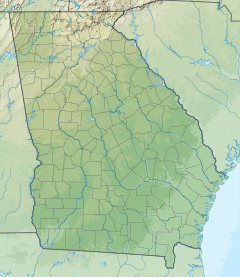 Front cover of the 1949 Masters Guide | |
| Tournament information | |
|---|---|
| Dates | April 7–10, 1949 |
| Location | Augusta, Georgia 33°30′11″N 82°01′12″W / 33.503°N 82.020°W |
| Course(s) | Augusta National Golf Club |
| Organized by | Augusta National Golf Club |
| Tour(s) | PGA Tour |
| Statistics | |
| Par | 72 |
| Length | 6,900 yards (6,310 m)[1][2] |
| Field | 58 players |
| Cut | none |
| Prize fund | $11,000 |
| Winner's share | $2,750 |
| Champion | |
| 282 (−6) | |
| Location map | |
Location in Georgia | |
The 1949 Masters Tournament was the 13th Masters Tournament, held April 7–10 at Augusta National Golf Club in Augusta, Georgia.[3] This was the first year that the famous Green Jacket was awarded to the tournament winner, and previous champions were awarded theirs retroactively.[4]
Sam Snead shot consecutive rounds of 67 on the weekend to win by three strokes over runners-up Johnny Bulla and Lloyd Mangrum.[5][6] This was the first of his three Masters victories and the third of his seven major championships. Snead also won the next major, the PGA Championship in May, and became the first to win those two in the same calendar year. He was followed by Jack Burke Jr. (1956) and Jack Nicklaus (1963, 1975); they completed their doubles in the summer (July, August).
Previous champions of both the Masters and PGA Championship, won in different calendar years, were Gene Sarazen, Byron Nelson, and Henry Picard.
Defending tour player of the year Ben Hogan did not play in the majors in 1949,[7] due to a near-fatal automobile collision in west Texas in early February.[8][9][10] Prior to the accident, he had won twice in January and was a runner-up in a playoff.[11][12] Hogan returned to the tour on a limited basis in 1950 and won six more majors (nine total), including the Masters in 1951 and 1953. He finished fourth in 1950, in his first major back.
Founder and host Bobby Jones (1902–1971) played in his last Masters the year before; diagnosed with syringomyelia and recovering from spinal surgery, this was his first as a spectator.[7]
- ^ Keeler, O.B. (April 8, 1949). "Masters field chases Mangrum". Miami News. p. 2-B.
- ^ "Middlecoff man to beat in golf". Eugene Register-Guard. Associated Press. April 7, 1949. p. 16.
- ^ "The Masters leaderboard for 1949". augusta.com.
- ^ Kindred, Dave (August 2013). "The case of the missing green jacket". Golf Digest. Retrieved April 17, 2014.
- ^ Bartlett, Charles (April 11, 1949). "Snead cards 267; wins Masters with 282". Chicago Daily Tribune. p. 1, part 4.
- ^ "Snead tames putter to win Masters title". Milwaukee Journal. Associated Press. April 11, 1949. p. 4-part 2.
- ^ a b "Wide open Masters tourney starts in Augusta Thursday". Pittsburgh Post-Gazette. Associated Press. April 7, 1949. p. 21.
- ^ "Golfer Ben Hogan injured in car crash". Chicago Daily Tribune. Associated Press. February 3, 1949. p. 1, sec. 4.
- ^ "Ben Hogan is seriously hurt as car, bus collide head on". Milwaukee Journal. United Press. February 3, 1949. p. 6, part 2.
- ^ "Improving Hogan will play again". Chicago Daily Tribune. Associated Press. February 4, 1949. p. 1, part 3.
- ^ "Hogan cards 69 to top Demaret in playoff". Chicago Daily Tribune. Associated Press. January 26, 1949. p. 3, sec. 3.
- ^ "Demaret beats Hogan by 3 to win playoff". Chicago Daily Tribune. Associated Press. February 1, 1949. p. 3, sec. 3.

